To be entirely honest, the thought of reviewing the adizero Boston 5 (or plainly called the Boston Boost) crept in only after some readers mentioned it in our comments section. If not for that, we would have simply passed it over, because the Boston Boost looks near identical to Adios Boost 2 when seen in pictures – except for some small tweaks on the midsole/outsole. So firstly, thank you for commenting, love it when you do. Secondly, having a pre-conceived notion is indeed a serious folly for a shoe reviewer. That to pre-judge a shoe based on how it looks. Sometimes, that works, but in this case, the Boston Boost wear-test punched some rather large holes in our assumption.
For a shoe which could very well pass off as Adios Boost’s Doppelgänger, it has quite a few areas of differentiation worth writing about. Actually a full notebook page’s worth of scribbled shorthand. Well, not literal shorthand, but a jumble of broken sentences and words in barely legible handwriting. But they come in very handy, and sentence by sentence, these connect and expand into a full review. Hopefully, that should result in a course of action which could have you:
a) Consider the Boston Boost over Adios, or vice versa.
b) Buy both shoes – the Adios and Boston.
c) Not buy it at all.
It would seem proper to start having fun with the upper first, since it looks so similar to Adios. Like some of our other reviews, we don’t have history with previous generations of Bostons, so feel free to sound off in comments if you’ve got some informational nuggets to share. Because of its strong visual resemblance to Adios, we’re drawn to compare the Boston with it throughout this review. This comparison will be of little use to you if you have no interest in the Adios. But in doing so, we trust that we’ll be able to lay bare the Boston’s character traits – something which will help in case you’re looking at the Boston from a standalone perspective.
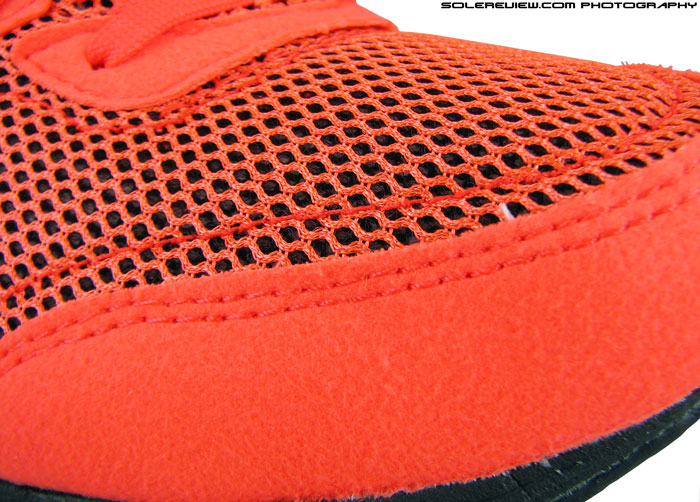
Similar materials to the Adios, though the suede texture is smoother, and the mesh thicker and spongy.
The Boston 5 upper appears near indistinguishable from the Adios at first glance. You’ve got the combination of synthetic suede and open structured air mesh, to the extent of individual patterns assuming similar shapes and positions on the upper. The synthetic is Tirrenina Suede, but with a smoother texture; the one used on Adios was more fibrous. Strangely, while the Adios Boost came tagged with paper label briefly describing what Tirrenina was, the Boston Boost just has the tag for Continental rubber. However, adidas mentions the Boston as being made with Tirrenina.
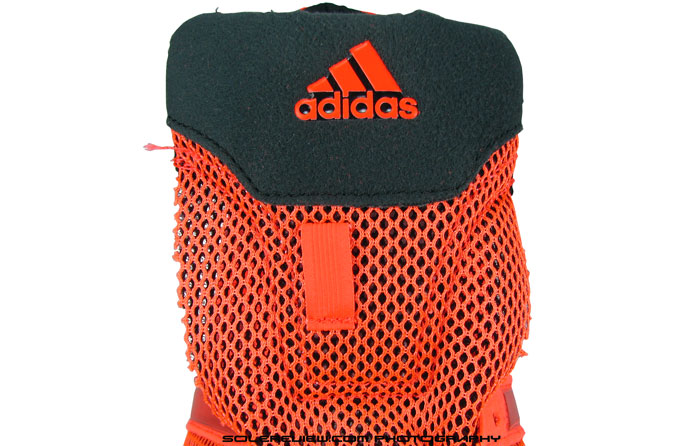
Lace loop on the tongue is a clever little trick. It is fixed asymmetrically (off-center), so as to prevent the tongue from sliding laterally.
Mesh looks close to Adios, but is actually more padded. There’s noticeably more sponginess when you squeeze the mesh between your fingers. The tongue is made of the same material, but at the top there’s a section of foam sandwiched, synthetic suede with the adidas logo welded on it. Collar lining is soft mesh spartanly backed with foam, and provides a snug feel due to how the heel counter is molded – we’ll talk more about it later. Tongue slide is near non-existent, as an asymmetrically placed tongue loop is stitched on, mirroring what’s on the Adios Boost 2.
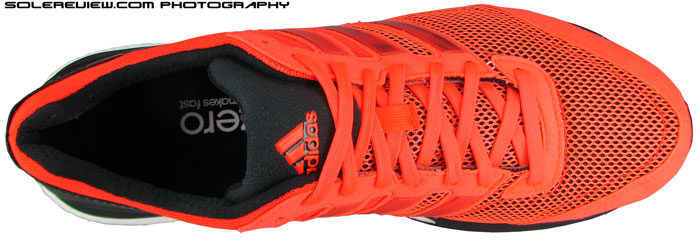
The wear-tested Boston 5 was half size larger than Adios (US 11 vs. US 10.5). Yet, the Boston sizing felt the same, meaning it runs half size smaller than Adios.
Yet, the fit feels quite different. There are many parts to this, but the most significant component is sizing. For this review, we bought a US size 11 (vs. a 10.5 in Adios) since we wanted some more room. But strangely, when it boiled down to heel-to-toe sizing, both felt exactly the same, with equal amount of space left (or not) ahead of the big toe. Considering that the two shoes should have a fit difference corresponding to half a centimetre of size increment, the outcome felt odd. The only probable reason is what we’ve experienced on other shoes – that there’s a difference in how the heel molding is executed, which in turn affects overall size.
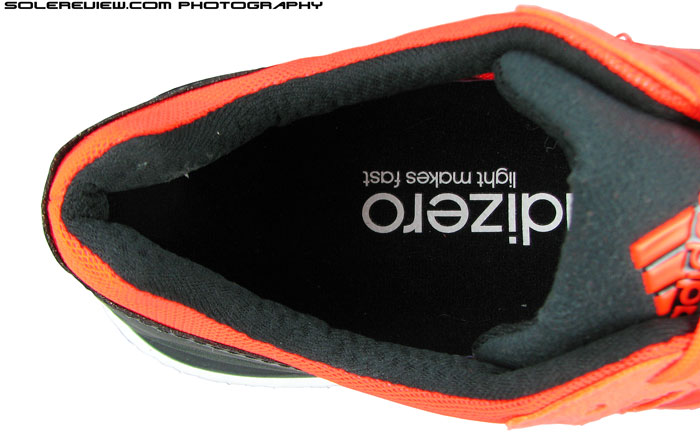
The heel counter has a narrow molding, and a leaned-in Achilles dip. This pushes the fooot forward, eating into forefoot space.
The heel is molded much narrower on the Boston, creating a pointy back end and an Achilles dip with a forward lean. This is in contrast to the more-rounded contours of the Adios heel, and causes the foot to shift slightly forward – and justifying the half size down. The toe box is very shallow, causing the toe to push against the ceiling of spacer mesh.
Apart from the actual sizing, overall fit is a bit more relaxed. The Boston Boost’s toe isn’t as pointy, opening up some space on medial (inner) side of big toe. There’s also more mesh on both inner and outer forefoot sides, which helps increase foot splay. But we suspect that it’s not only the design and pattern change which results in the fit difference, and there’s more to what meets the eye. Before diving into that topic, let’s have a look at what’s going on in the midfoot area.
Just know that we’re using the word ‘relaxed’ for the Boston 5’s fit purely from an Adios Boost context. When compared to most shoes, the upper fit is quite snug, and that reflects in how we’ve graded Boston 5 in our sensory scorecard.
The upper midfoot is snug, but feels more spacious than Adios. The lacing width is broader, with more space between opposite eyelet holes. This, combined with an overall thicker tongue mesh and synthetic leather flap, reduces the intensity of top down lacing pressure felt in the adios. But like we said, there seemed to be more to this than these tweaks. We believe that the Boston 5 Boost uses a wider version of the Adios last, despite online 3D scanning apps like ShoeFitr saying that both shoes have identical fits.
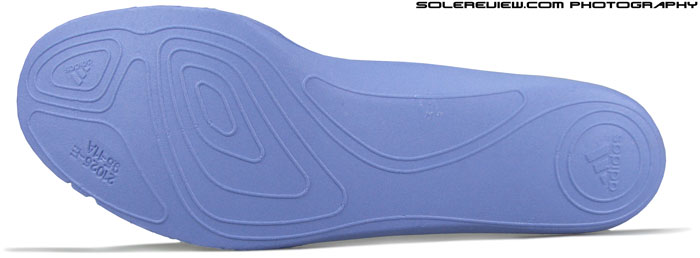
The reverse side of insole. As called out in our Adios Boost review, this texture is a carryover from 2007-2008.
Most running shoe insoles have last markings mentioned on its reverse side, and comparing the Adios and Boston throws up something interesting. Both (see picture above) have the last number 21026 molded on them, except for the suffixes. The Adios Boost has a ‘D’ suffix, while the Boston 5 has an ‘E’ appended to the number. This, in our view can mean only one thing – that Adios uses a standard D width last, while the Boston uses a wider, E sized last. Given that the dimensional difference between D and E is 5 mm, this would explain the relatively relaxed fit of the Boston 5.
Consequently, the midfoot doesn’t wrap around the arch as well as it did on the Adios, but the Boston Boost betters its racing counterpart in one area – the midsole wall edge does not poke into the underfoot, and that’s because of how the midsole is put together.
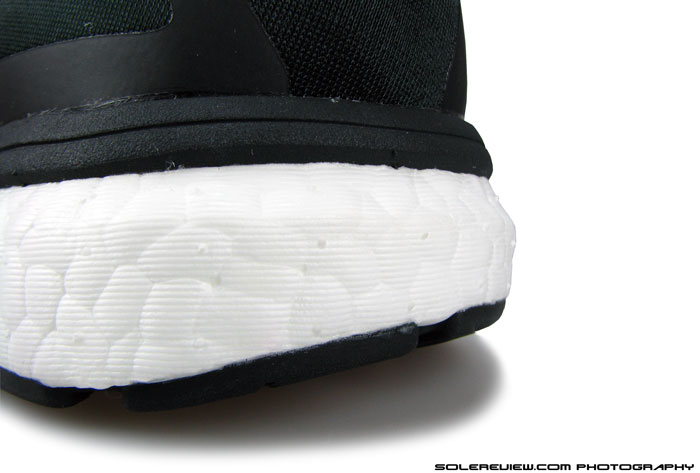
Looks like many of the other Boost models, doesn’t it? EVA layer on top, Infinergy foam sandwiched in between.
Side profile view of the midsole is a familiar sight if you’ve kept up with recent Boost launches. There’s a visual rim of EVA on top, with the white Boost foam sandwiched between the latter and rubber outsole. In some shoes like the Energy Boost and Adios Boost, the EVA is only a mere rim surrounding the upper base, with the center being Boost foam core. But shoes like the Supernova Glide and Sequence Boost, along with today’s special, our good friend Boston 5, feature a real layer of compression molded EVA beneath the insole. This obviously swings ride dynamics.
The Boston 5 Boost is more cushioned than the Adios. A good way to put this is it sits somewhere between the raceday Adios and easygoing Supernova Glide Boost. If the gap between them was represented by an imaginary scale, then the Boston 5 would sit nearly in the middle, but with a slight bias towards the Glide. There are a few factors involved here, and we’ll run through them one by one.
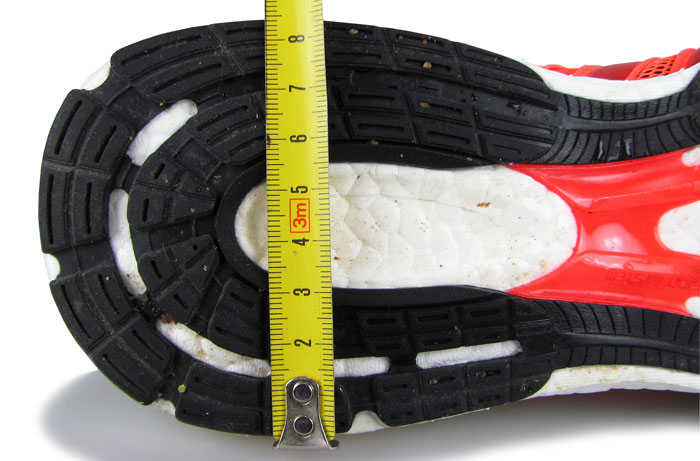
The heel base is slightly wider than Adios Boost, along with more volume of Boost foam. Also notice the oval shaped opening under the heel, and the articulation of the heel crash pad. Multiple slits allow a great range of movement for the heel outsole during footstrike.
The volume of Boost foam is higher than that of the Adios, and also with a corresponding increase in width of the heel base. Not so much, but even a few millimetres swings the needle. Along with that, toss in firm midsole EVA over the Boost foam. This midsole layer extends from heel to forefoot, where it ends and leaves only the layer of fabric strobel over Boost. When weight is loaded on the midsole bed, it tends to compress the Boost foam in a more widespread manner. This is in contrast to the immediate cushioning feel of the Energy or Adios Boost (though to different extent), where cushioning feels more localised and concentrated over a smaller heel area. The midsole acts as a pressure plate of sorts, somewhat similar to what Nike has done with the cardboard layer over heel Zoom Air the past few years.
The outsole design also amplifies the cushioning feel. Right under the heel, there’s an open space in shape of an elongated oval, which trampolines a bit during foot strike. The lateral rear-foot area of the outsole has some amount of articulation built in by means of open slits (showing the Boost foam through), so when you land rear-foot/heel first, that portion tends to breakaway more efficiently. This increases the range of motion of the crash pad, elevating cushioning feels. And in typical adidas fashion, there’s a good amount of bevel under the (lateral) heel which smoothens rear-foot strikes.
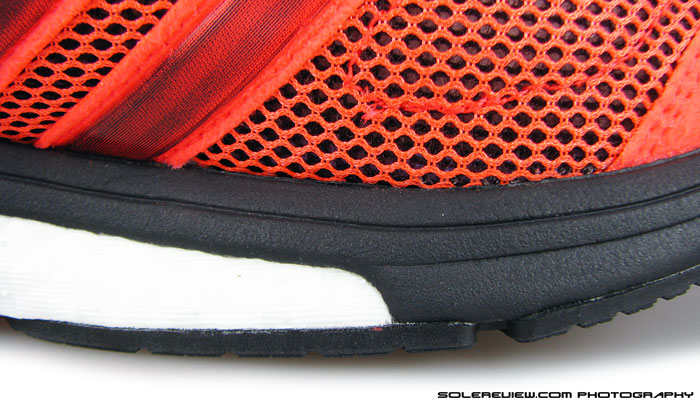
Going by side profile, it looks like the Boost foam stop here. But no, it continues further inside – see next picture.
Forefoot is decently cushioned; there’s a good chunk of material under the foot, a combination of Boost and EVA. From the side, it would appear as if the Boost portion ends just short of the forefoot, but turn the shoe over and you’ll see Boost extend right till the toes. The EVA part acts as a kind of an external cage. Admittedly, if you were expecting the Boston 5 to have a very focused front-end like the Adios, you’ll be disappointed. The relative thickness of forefoot robs the Boston of the excellent ground feel and grip witnessed on the Adios, which means that track workouts are going to be less rewarding.
The bright side depends on how you perceive the Boston 5 Boost. In our opinion, the Boston 5 is more a daily trainer good for fast paced runs than a pure raceday shoe, which the Adios is. The cushioning levels are adequate enough to go the distance, and the bottom is a layer of Continental branded outsole rubber. This makes the shoe more durable, especially under the forefoot. Grip is more than adequate, though Continental’s grip on wet surfaces isn’t as cracked up as people make it out to be. It so happened that one of the test runs happened on roads after a brief spell of showers, and we did not notice any incremental levels of traction over regular outsole rubber.
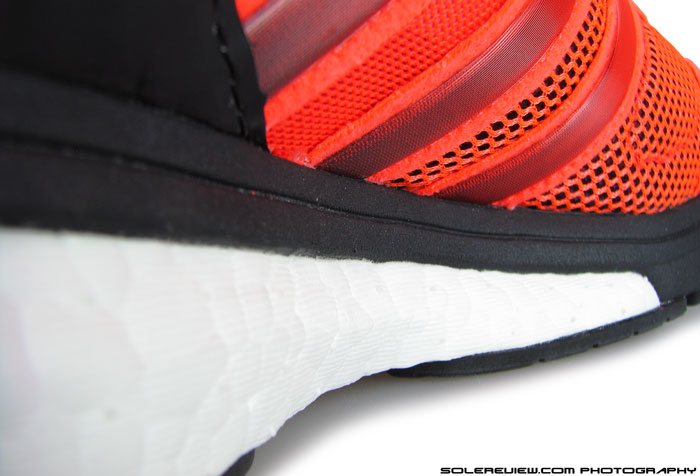
Since the edge is an extension of the EVA midsole layer inside and not just a rim, arch poke isn’t felt.
Running continuously over 7-10 kms in the Adios Boost 2 gave us under-arch soreness due to the sharp edge of midsole rim, so we were naturally apprehensive of the same happening in Boston 5. But none of that experience repeated itself. In the Adios, the EVA rim poked in because it was hard, and was well, just a rim sticking upwards. It’s a different situation on the Boston. The edge is part of the midsole and not a rim, and the material is softer too. So the midfoot is resting on the EVA midsole, which takes most of the pressure. Any potential dig is dulled by the insole, so we were relieved not to go through it again.
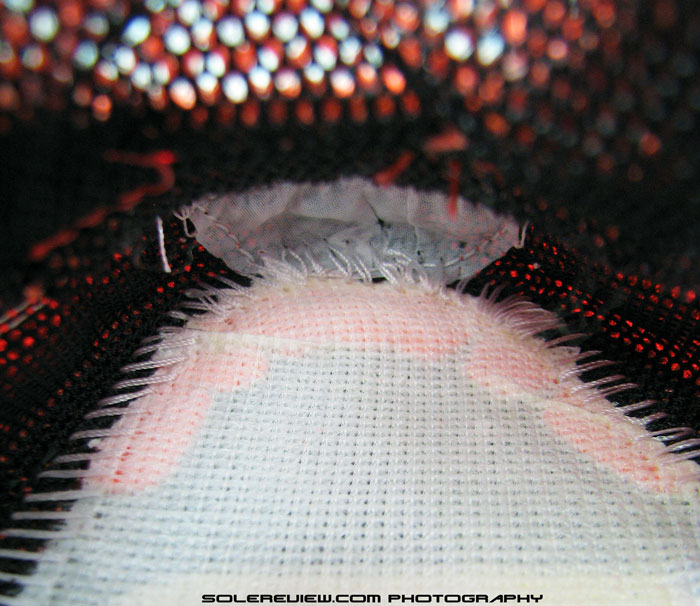
Like the Adios, the Boston5 disappoints when worn barefoot. Here’s a picture of how the toe box looks like from the inside – the portion on lateral big toe irritates.
Barefoot running incompatibility plagues the Boston 5, as it did the Adios. The materials and construction are nearly the same, so it ends badly if you decide to trade your socks for birthday shoes inside the Boston. The tongue edges fold over inside and press/scratch against the foot, leaving a temporary impression (of the mesh folds) on the skin after a run. The lateral side of u-throat (near start of the lacing) and sides of the big toe also feel uncomfortable. Could barely continue after a few kilometres, after which point the socks came back on again. It is becoming pretty obvious that brands don’t pay much attention to how their shoes feel when worn barefoot, going by our less than ideal experiences with recent shoes. At times it is liberating to wear the shoes sans socks, and materials like an airy spacer mesh make for a sweet deal when you do.
If you’ve got no experience with the adios Boost, and want nothing to do comparing the Boston against it, then just see the adizero Boston 5 as a lightweight, neutral trainer with elements of speed dialled in. At 262 grams/9.2 ounces, it weighs far lesser than many neutral running competitors, and the snug upper gives it bit of a distance racing flat character. The Boost foam feels cushioned, supportive and responsive, as has been our experience with most adidas Boost shoes we’ve tested this year. (except the Pure Boost).
The shoe can be best described as a hybrid between a traditional, 300gm+ neutral runner and a distance road racer, an uncommon category we’d also plug the Mizuno Wave Sayonara 2 into. And before we forget, adidas calls out that a portion of sales from this shoe go to the ‘Boston One’ fund. In case you’re wondering, the Unicorn logo is for the Boston Athletic Association, organizers of the Boston Marathon.
(Disclaimer: Solereview paid full US retail price for the shoe reviewed)
Note on ratings: Our numeric scoring of 8.5/10 is based on a total of weighted averages. The attributes namely transition, stability and fit contribute to 69% of total scoring weight, which we see as more important than material (7%), cushioning (7%), traction (12%) and weight (5%). Hence the scores will not add up when a method of simple average calculation is used.


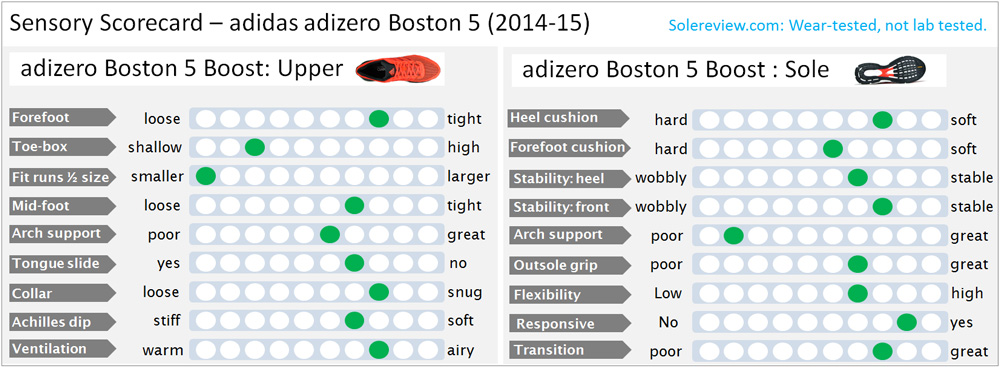
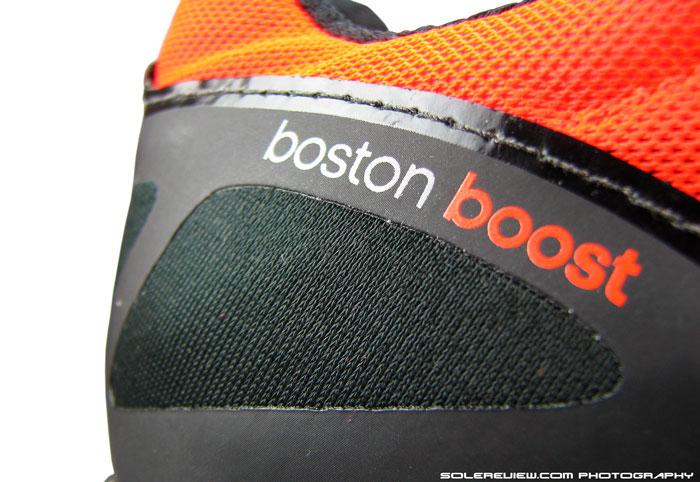
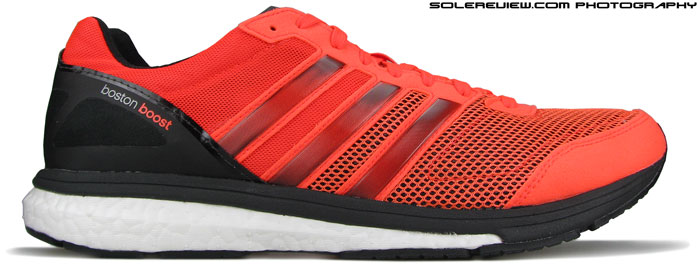
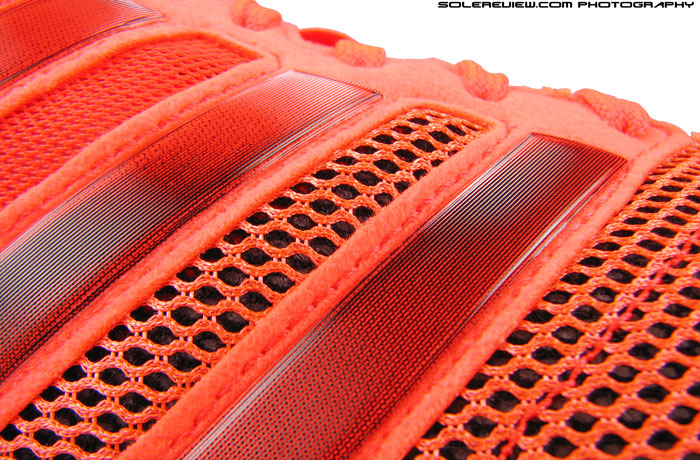
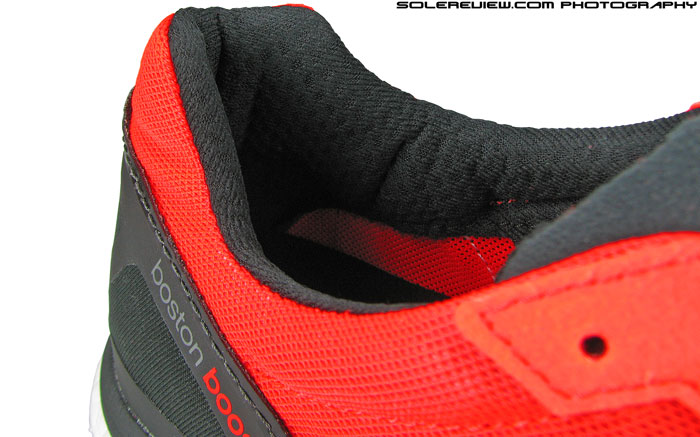
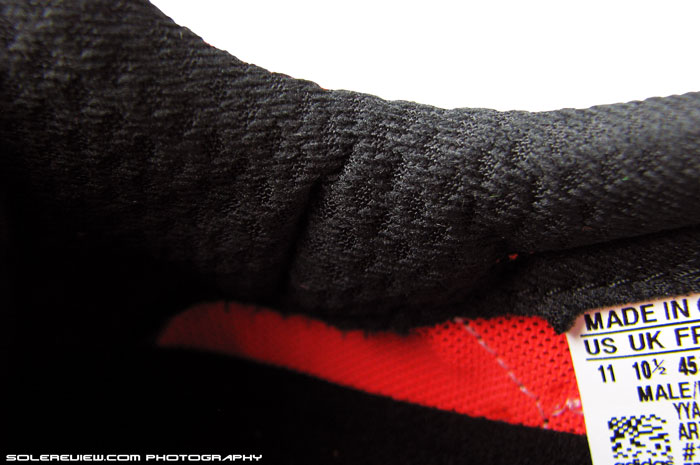
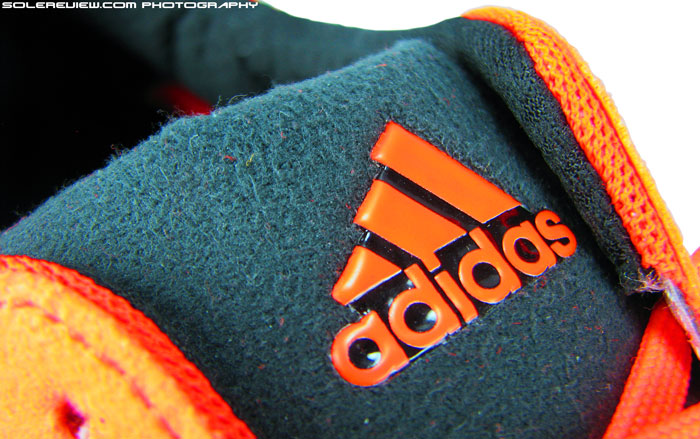
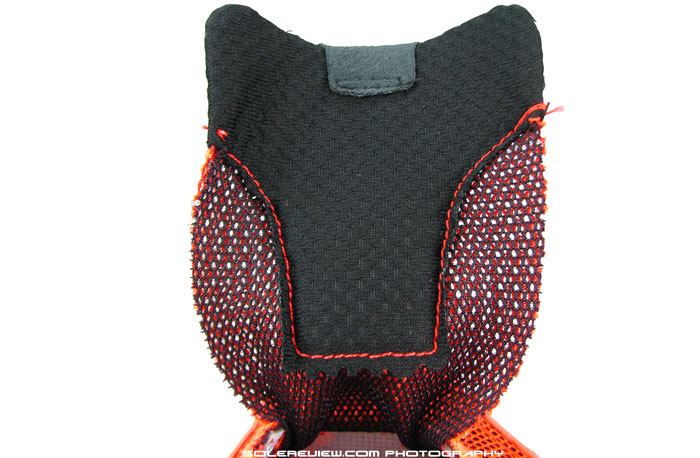
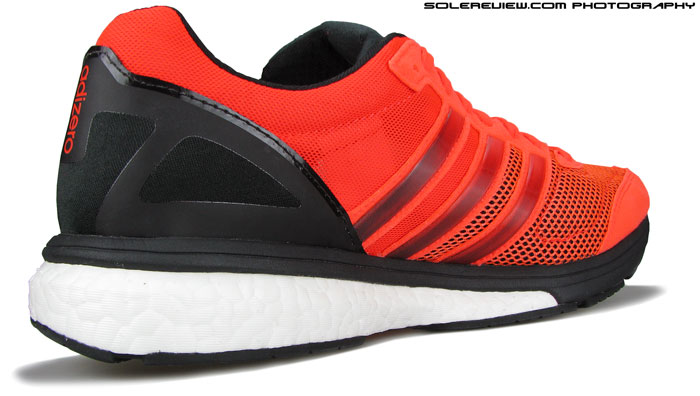
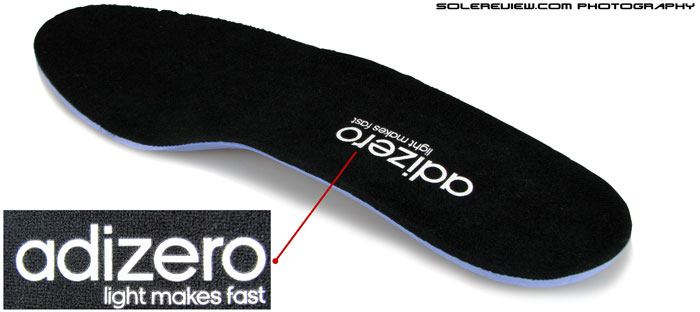
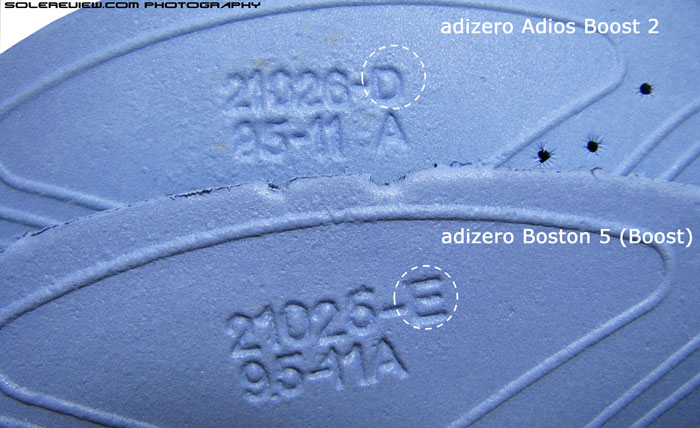

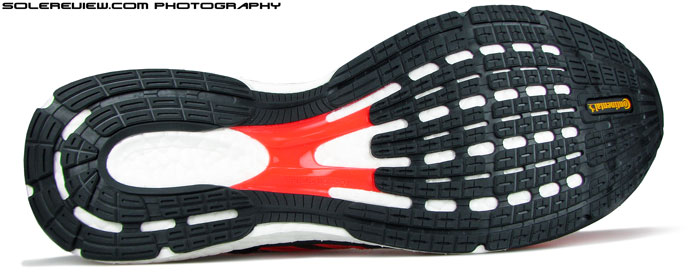
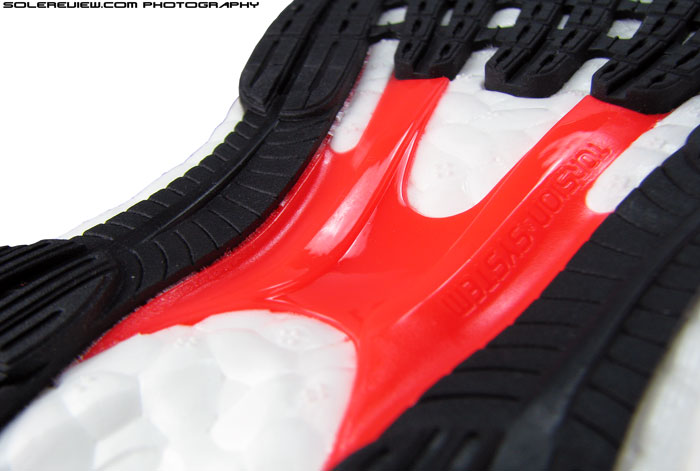
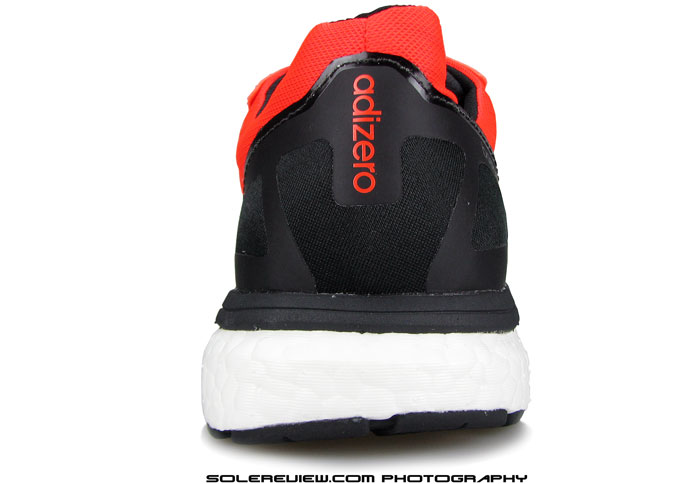
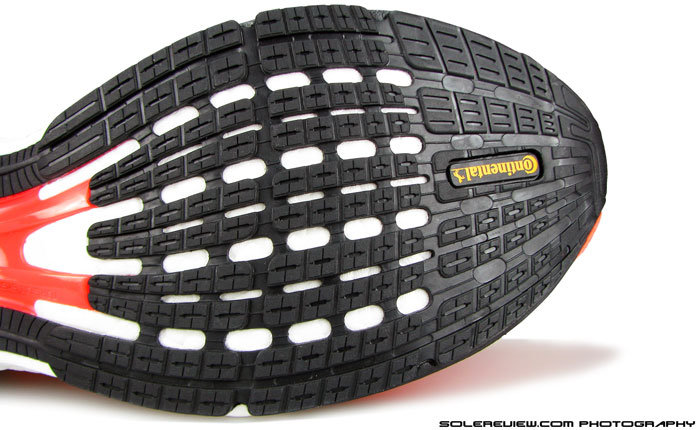
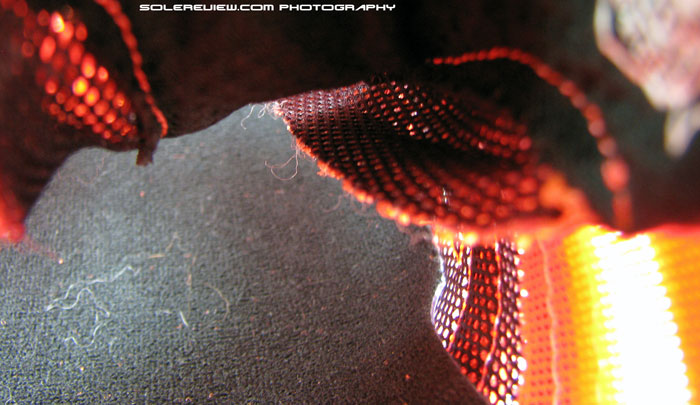
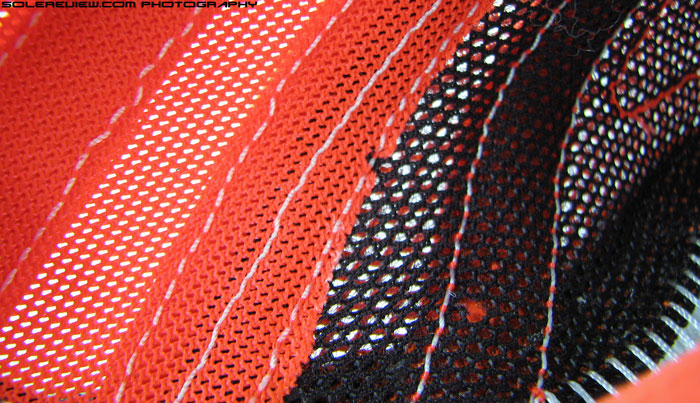
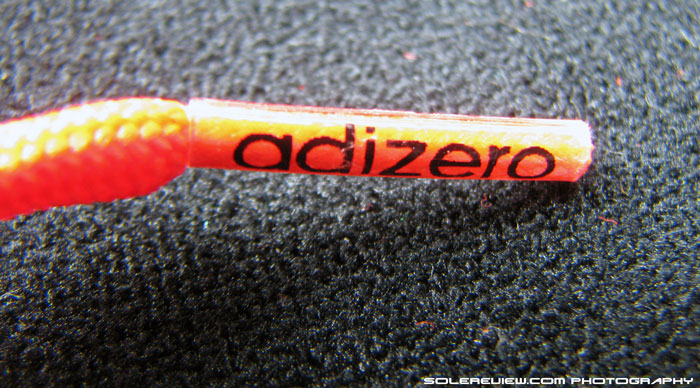
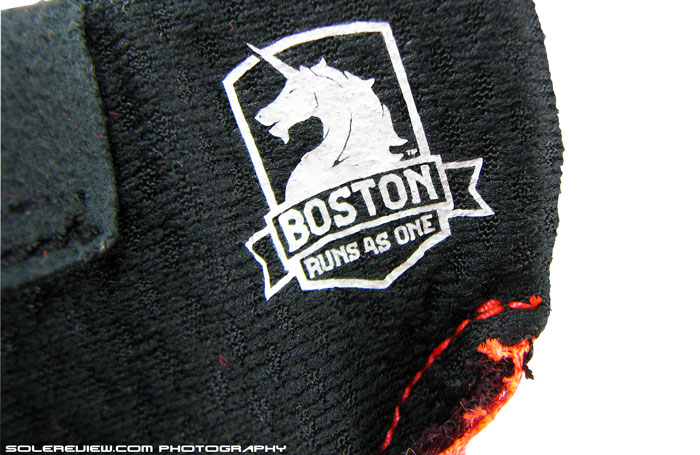
123 comments
Thank you for the excellent review — as always. I see you don’t mention the Nike Pegasus 31 as an alternative to the Boston 5. Could you briefly comment on the differences between those 2 shoes? Thanks and keep up the excellent work!
Thank you for the comment, Andrea!
We did not include the Pegasus as we see the shoe belong to the traditional, neutral running category. Which means it comes with properties like a much softer ride (compared to Boston), a higher weight and overall relaxed+plusher fit. Compared to Pegasus, the Boston Boost feels more business like in its approach towards delivering fast paced training workouts. That is the reason why we suggested the Zoom Elite 7 and Streak 5 as alternatives to Boston 5.
In the adidas scheme of things, the Pegasus would be pitted against its Supernova Glide Boost.
Crystal clear! Thank you very much.
I’m addicted to these reviews. Thank you, Solereview! I’m a heavyweight neutral runner (215lb) and I’m looking for a safe and comfortable shoe for my everyday runs.
Between Adidas Energy Boost 2, Nike Pegasus 31 and New Balance 890v4 (or else), which one do you recommend?
Hope we can keep up with the new reviews so that you keep coming back!
Haven’t had the chance to test the 890 V4 yet (we’re waiting for the V5 release in December) so can’t comment. Between the Energy Boost and Pegasus, the Energy Boost would have been our choice if not for the super snug midfoot+forefoot. If you’re okay with that, then we’d say the EB.
Else, the Pegasus 31. Or even the Saucony Ride 7.
Thank you very much. I live in Brazil, in a city where the average temperature is 30C (86F) and I need a breathable shoe to avoid blisters and disconfort. And we don’t have Saucony here. I’ve been running with Lunarglide 5 (ok) and Asics Nimbus 15 (too warm). Looking foward to a new pair. Thank you again.
Got it.
The Pegasus 31 runs a bit warm due to the full inner sleeve. You could try the Energy Boost 2 ESM or the adidas Supernova Glide 6 Boost, which should breathe better.
Hai, solereview. Ola, Joao,
Same situation with Joao, heavy runner (95kg), neutral foot, hot tropic climate (31 at day & 28 at night) & I’m also looking for new shoes to replace my worn out running shoes, Brooks Ghost 6.
Being eying Nike Pegasus 31 & Adizero Boston Boost 5 for awhile and thanks to you add Supernova Glide 6 to the list.
Question, are those comparable with my Brooks Ghost 6 ? I already like the shoes but have to move to other brand coz my local shoe store don’t carry Brooks anymore. Don’t have Saucony either.
Hi there! Great to see more readers from Brazil :)
The Brooks Ghost 6 has an unique ride and upper, so the Pegasus, Boston and Glide are all very different from it – though all three are great shoes.
However, within that narrow list, the Supernova Glide 6 could be a good alternative. It is not as soft as the Pegasus, yet more than the Boston. And as we told Joao, the upper is breathable too.
How about the Asics GT-2000 2? Again, a different shoe from another brand and category (motion control), but upper construction is vaguely similar to the Ghost.
Thanks for your reply…
Well…actually I’m from Jakarta (Indonesia), that’s why the climate little bit same like Brazil.
I will look into Boston 5 & Glide 6, but for Asics I’m not sure where can I can get hold of it. I will test those two + Pegasus 31 before open my wallet, it happen that Nike store & Adidas are neighbor in the same shopping mall…hehehe
Once again thank you for your personal approach toward your readers. Sure will come back for more new shoes shopping in the future.
Sorry about the mix up! Jakarta – great place, but the traffic…
Yes, makes sense to try the shoes on first and see how they fit you!
Have a pair of these, durability is the #1 standout feature to me! By the way, have you guys ever thought about reviewing the New balance 1400s?
Appreciate the insights! Yes, the NB 1400/1600 V2’s have been considered, maybe in December or so. Right now, we’re booked solid till end November.
Great, highly informative review as always! Thank u! Hope a basketball shoe review on the Adidas Rose 5 boost is in the pipeline!
It’s a looong pipe, sir.
Great review, thanks! There be’d some back and forth comments in the AB2 review so that’s a nice summary. I own both the Glide Boost 6 (GB6) and the Boston Boost 5 (BB5) and tried the Adios Boost 1 (AB1) for a 10×400 session on the track. I used to wear US11.5 (had the Adidas Tempo in that size) but my big toe was a tad too close to the tip generally so I went for US12 with the GB6 (had done the same with the Asics GT2000 v2 but sold these as they were really too big and hurt my left achilles for some reason) and find them ok, although the toebox feels a bit large and while great for easy and even tempo runs, there isn’t enough support for 10k speeds (4’/km) or speed work. So…I went out and got the AB1 on sale in US12, however the toebox felt even bigger so I didn’t keep them.
The BB5 looked like they would make sense but in US12 they are way too tight in the front for comfort. The length is ok so US12 does make sense, but the width is really not what it should be. I usually run with some slightly padded socks (useful with GB6) so i tried some thinner ones and it helped a bit but it’s not pleasant and actually gave me some bad blisters on the left below my small toe. A bit odd since my right foot is a bit larger…Last night before your review came out I saw some Shoeftr comparisons and they do say that if the GB6 fits well in 12, you should go 12.5 in the BB5. Your review confirms that. As you point out though they don’t seem to find much of a difference between the BB5 and AB2 in terms of sizing/width/profile…Anyway I have a pair of 12.5 BB5 on their way to me as I type this. Oh and the reason I’m ready to go through this trouble with them is that I really like the way they “handle”, better ground feel than the GB6 of course and really quite dynamic. Being a midfoot striker the heel part I haven’t paid attention to the feel in the heel.
Once I’ve sorted the BB5 situation I might still give the AB2 a go at some point for 10k races but your comment about the midsole rim “digging” does not make them very tempting. At my speed and weight (165Lbs) the BB5 would probably do the trick on 10Ks anyway. Too bad I won’t have my 12.5 BB5 for my challenging 20k race tomorrow, will have to tighten the GB6 to the max ;-)
Wow that was long, sorry about that ;-)
PS – I don’t have my BB5s handy but on your picture the insole of the BB5 seems to read 21025 vs 21026 on the AB2, or is that just a picture artifact?
Wow, that was a very detailed comment, thank you!
Our theory behind the GT-2000’s left Achilles stress is that due to the difference in length between your left (smaller) and right (larger) foot, the left forefoot will sit slightly towards rear of the shoe. This could have reduced the effective heel to toe drop, which will naturally put stretch pressure on your Achilles and/or Soleus. That’s the only reason we could think of.
Blisters are also caused by loose footwear, which the case seems to be for your left foot. Would look forward to your experience with size 12.5 BB5. The (potential) arch poke is something you’ll only find out when you wear the AB2. It might or might not flare up.
Good spot on the last number. That isn’t an artifact, the 6 looks like a 5, but we think it is actually a 6. Look at the number ‘9.5’ just below that, and you’ll see the straight (head) line of the 5, and also there’s some gap between the tip of the lower curve and upper portion.
Footwear molds go through a lot of abuse so likely that the 6 is bent out of shape and looks a bit goofy. Something like correcting a ‘5’ to a ‘6’ on a chequebook :)
Thanks for sharing your thoughts on the my left Achilles issue, the different drop due to the the size might indeed come into play. Running with the GB6 it flared up during my 20km race on Sunday the 20km Marseille-Cassis “classic” with a 10km climb followed by a flat and descent, very demanding on the Achilles I suspect, but fabulous scenery ;-) It felt really stiff on Monday morning but it’s pretty much back to normal now. I’m going to give my orthotics another try to see if that helps, I’d given up on them when I switched from a heel to a midfoot strike last year.
Back to the BB5, there was a mixup at the online shop where I ordered the 12.5 version but I should get them tomorrow and will give them a test run ASAP.
Hill climbs are natural Achilles and Quad busters, so too much of a variable to say if the GB6 is at fault.
Good luck with getting the properly sized BB5, look forward to your experience!
Yes, I wouldn’t incriminate the GB6, more my own “specs”, sensitive Achilles and with that kind of terrain they’re going to be under a lot of stress.
Anyway my 12.5 BB5 came in today and they are a lot more comfortable, the front of my foot no longer feel like it’s locked into a straightjacket ! They don’t seem to be any longer actually, just wider. Will try them out on a track session tomorrow.
Well that didn’t go very well. For a start the ground feel I have with the 12.5 is very different than with the 12. The 12 gives me a smooth transition but the 12.5 feels “disconnected” with a “gap” in the middle of the transition…I suppose it comes down to the slight size difference, quite odd! Besides, the blister I got with the 12 under my small left toe came back with a vengance. Not sure what to think now, especially since the 12 have stretched after a couple of runs. I guess I’m keeping the 12 and will use them for 10k races. I’d still like to try the AB2s, will go back to review…
Sorry to hear that, but guess that is what running shoes are about. Variables, variables…
Yet another update, with some good news this time ! I kept the size 12 BB5 and after some test runs at race speed last week where they felt great (fast, good ground feel and “race tight”) I decided to use them for an HM on Sunday and it went fine. Thin socks, no blisters (anti-chaffing applied liberally) and the tightness gave some good control at my 4’15″/km pace.
So in the end it was well worth sticking with the BB5! I think the original “shock” was due to the “slipper” feeling of my regular GB6 shoes and they certainly “stretched” after a few outings.
Now on to breaking in my AB2 (size 12 too) for a 10K in early December where I have to break the 40′ barrier I “toyed with” in February and June ;-)
Like they say, all’s well that ends well.
40′ for 10 is a big deal, good luck!
Great review, much better than RW’s. Boston has always been my fav but I really cannot say I 100% happy with them. For price tag of $120, they seems a good buy than $140 adios material-wise: more foams, more rubbers. But my Boston 3 only last about 400K and things to start fall off (I only weight 61KG). Compare to my adios 2 and adios boost, I do not understand why quality on Boston seems worse than adios, since the uppers are identical. I will definitely getting a pair of these when I finish with my EB2. Or maybe consider the future release of the Tempo Boost. I guess you will review them, right? :)
Thanks for the feedback and sharing the Tempo Boost pictures – yes, we’ll review them in Spring when they’re out.
Great review as always – much appreciated.
I’ve got 10 pairs of running shoes in rotation at the moment and imo the Boston Boost is a full size smaller than any other shoe I own. Also got the Adios and Glide Boost. I like snug models, but BB5 is just too tight and something seems completely off with the sizing of that very pointy toe box. It helps a bit running without the insole at all.
I also recommend you to review the 890v4. It looks like a tank, but surprisingly has been one of the most swift, while still well padded, trainers I’ve ever had – especially when running midfoot. Another recommendation would be the Hoka Clifton for those really long runs. Just absolutely an amazing amount of cushioning in a 200 gram shoe.
Thank you for the kind words.
We felt the same with the BB5 sizing, the heel tends to push the foot forward and knock off half a size.
Appreciate the suggestions; we had plans to review the 890 V4 but dropped it. The new 890 V5 is around the corner, so we’re trying to our money’s worth by reviewing a brand new release!
The Hoka Clifton Review is on track, will follow after the WaveRider and Structure 18 this week.
Great review, but I just wanted to say that the sizing issue isn’t going to affect everyone. I may only be a sample of one, but I have no problem fitting into these (size 11), and I wear 11 in every other shoe (including the Peg 31, Energy Boost 2, Glide 6 Boost, and Adios Boost 1). Maybe I have a pointy narrow foot or something! My friend didn’t have to size up either, so my advice with this shoe (and any other for that matter) is to definitely try it on and don’t just assume you’ll have to size up!
I do use the lacing trick where you use the top islet to lock the heel down, so perhaps that is keeping my foot from sliding up thus preventing the need to size up. Who knows.
Thanks for sharing your experience – that’s the exact advice we give in the comment section – you won’t know for sure till you try them on for yourself!
Reviews are just one of the few reference points when deciding to buy a shoe. It is perfectly ok to disagree, and we understand that. There are just too many variables involved to be able to arrive at a single conclusion for a shoe.
Interesting but in my (and others I believe) case it wasn’t so much the length than the width in the front. You probably have a thin foot, or size 11 is truer to size than other sizes, like my size 12. That would tend to be confirmed by the fact that the GB6 in 12 is slightly too roomy for me but it seems ok for you in size 11.
Glide Boost size 10 and Adios Boost Size 10 1/2 fit me perfectly, but I just tried the Boston Boost size 10 1/2 and I’m thinking about sending them back, its just feels too tight for a full marathon, maybe shorter runs are OK. I agree it’s not the length but the narrowness of the toebox.
I’m a bit annoyed that Adidas apparently aren’t producing this shoe (or the boost 2.0) in a size bigger than US13, especially as these shoes are a bit smaller than other US13. I’d love to get a pair of the Boston 5 but I tried the US13 and the are just too small. Come on Adidas, my feed are big but not that big…
Didn’t notice it till you brought this up – looked around and you’re right, size 13 is as far as they go!
Just bought the BB5 yesterday. Not on plan but saw it at 30% discount was just irresistible. Great and super thorough review. Solereview you are simply the best.
Didn’t size up. Bought my usual Size US10. Will have to wait until next Tues/Wed to try it out. Too high mileage than my usual already this week; more than 70km. Bonked this morning : (. Currently using the Nike Free 3.0, Nike LG6, Adidas GB6. All great shoes. Will let you know how it feels.
Hi, thanks for the comment! Let us know it goes, would love to hear your feedback on all the shoes you are currently rotating :)
Had my first run in the BB5, however just a Tempo 12km. The shoes are indeed very light thus picking up pace is easy. The midfoot arch section is very tight and hold the foot very firmly; but not so at the forefoot section (I love the flywire forefoot snug feel of the original Nike 3.0). Somehow when compared to the GB6, the BB5 bouncy feeling is far less. I am not sure why as I have been told the BB5 has more boost material than the GB6. Nevertheless, the weight of the GB6 make it lose many crucial points to the BB5. The BB5 will be mainly reserved for my races for now after I do the break-in. : )
Prior to the BB5, I achieved many new PRs with the GB6.
My original Nike Free 3.0 I believe is no longer being in production (Bought them very cheap in Korea at a duty free Nike Premium Outlet a year ago and I really love them). The new Free lines somehow does not feel as comfortable as the original and I am really sorry Nike dropped the original flywire design and feel. I use it mainly for my interval workouts. Very fast & durable shoes too. Will miss it when comes the day to retire them as I know I can never get another pair.
The LG6 is very comfortable and light (for stability shoes comparatively). I use them for my long weekend runs. (25-30km). Wearing them make my legs less sore which is what I like as I am still far from Full Marathon material. Adding km week by week. Just saw the LG6 Flash which has generous reflective material and waterproof – bought them as spares and will remain in the box for a while. Had been told it will be 50% warmer cf to the normal LG6 but seeing them litted up at night are just so cool and most of my runs are in the very early mornings when it is still dark.
Overall, all the above are good shoes and I am satisfied. Will certainly consider their successors except the new Free lines.
Oh, I didnt size up on the BB5 and they feel fine for my feet.
Appreciate the very detailed feedback, Lee.
Actually what you say about the Boston Boost’s cushioning makes sense – it actually has less (not more) Boost than GB6. So it will feel slightly less cushioned compared to Glide. It is however, as you pointed out, a great shoe for fast runs!
Don’t lose hope on the Nike Free’s, they will come up with a new design next March. Maybe there’s something for you from their newer upper designs.
We haven’t reviewed the LG6 flash, but they do look cool in pictures!
Hi,
Looking at purchasing a new running as I am needing to retire my old Nike LunarEclipse 6. I loved the LE6s (bit chunky and heavy) but have become a better runner and am looking to move into a lighter and faster shoe, while still trying to keep it as close to the LE6s. I have read the reviews of the BB5 and EB2 from Adidas and have loved both and can see myself in either.
Just wanting to know which would be best?
I am running half marathons at the moment and looking to move to full marathons later in the year and need an appropriate shoe. Currently I am running at around 4min20sec per km. My stride is pretty neutral with the slighest of supination. I have medium arches and land flat footed whilst running.
Please would you advise on a suitable shoe to help speed and distance.
Thanks very much
Hi Dustin, did you mean to say Lunarglide 6? Just need to make sure we’re on the same page before we answer your question!
Hi, no sorry just looked at them and they are the old Nike LunarEclipse 2..
Thanks. We would also recommend the Supernova Glide 7. Kind of middle ground between the cushier EB2 and firmer BB5. Has enough cushioning to go the distance, but not so much as to bog you down
Hello
Solereview staff!
First of all, I’d like to say that I enjoy your reviews a whole
lot! I love the attention to detail, the amount of it, and the quality of your
explanations. You reinforced my decision to get the Glide boost 7 and I enjoy
them a lot. Thank you.
I have a question, if you don’t mind. I want a lighter shoe than
the Glide I have for faster workouts (hill repeats, running form conditioning)
as I am practicing for 5k races, just to participate and have fun. I’m a
neutral runner, midfoot striker with a somewhat flat arch. I use the Glide
boost, as I mention at size 11us and the Mizuno Wave Enigma 3 at 1 size
smaller (the accomodating forefoot allows this). I enjoy both shoes: The mizuno is more “focused” and the Adidas is more “cozy”.
Am I right to consider the Boston Boost and the Wave Sayonara as
good options? Which of the two should I gravitate more to? Are there other
options you could recommend?
A small side note; I tried to Wave Sayonara 1 in a store, but I
didn’t like how the upper felts above the forefoot; the mesh was stiff and dug
into my toes as I flexed my foot, even after sizing up.
Thank you in advance!
I forgot to mention that I’m not the slimmest of runners, measuring 178cm (5′ 10″) and weighing around 80kg (160 lbs.).
I also tried on the Adidas Tempo Boost 7, which felt comfy as far as forefoot room, but that torsion system was definitely noticeable. Do you think that it would work in my favor, having those somewhat flat arches? Or would it get in the way and hurt more than do good?
Last question is about sizing. It is common knowledge that a running shoe’s fit should allow space between the toe-bumper and the end of the longest toe (a thumb’s width). Does this principlerecommendation remain the same for lighter shoes, in which I wouldn’t put lots of miles in one training session or race? I don’t plan running more than 10 kilometers in them at any one time.
Thank you again and any sage advice would be greatly appreciated!
Thank you for the comment and the nice words! Great to hear you find our reviews enjoyable.
Based on our experience with SG and Boston Boost and Sayonara 2, we’d think that the Boston Boost is the shoe to go for. On paper, the Tempo 7 seems like a better fit for your requirements but can’t say for sure till the shoe enters our testing rotation.
Yes, we recommend maintaining a thumb’s width in all running shoes except track spikes.
Would you recommend the Tempo for someone who usually uses Saucony’s Guide and Mirage?
Can’t say till the time we get some miles on them. You could check back after a week or two, when we have our review online.
Thank you for the detailed reviews! As a shoe geek, I read every review on the net and I can definitely say that you do the best job by far!
I had never been an Adidas fan. Dead cushioning, quite inflexible and the Adizero line was too narrow.
BUT… after 100 Km, I can say that the new Boston is a really great shoe!
I rotate shoes like 1400 V1&V2, Fastwitch, Pure series and staff like that, mostly.
The BB5 is a trainer with racing flat feel, ideal blend of protection and responsiveness, nice snug fit, feels lighter than its actual weight and capable for every type of workout. It proves that a simple design, without bells and whistles, can do the job fine! I just wish it was just a bit more flexible.
Thanks for the feedback, Nikos!
This seems like the bargain of the Boost family of shoes. Wonder it isn’t sold in the specialty running stores or isn’t listed on their websites? A softer version of the Glide would be perfect for me. But the reported shallow toe box could be a deal breaker. And I haven’t seen a non tech fit version.
Actually, we see the Response Boost as the bargain Boost, but then, the forefoot is super shallow.
Oddly enough (or maybe not given the sizing/fit issues of the BB5) a BB6 with the Primeknit upper is already on its way !
http://www.trimes.org/2014/12/08/sneaker-geek-les-sortis-du-printemps-adidas-boston-6-new-balance-vazee-pace-saucony-kinvara/
http://i0.wp.com/www.trimes.org/wp-content/uploads/2014/12/Adidas-Boston-W.jpg
Ah, Nike and adidas both moving towards a Flyknit and Primeknit overhaul on many of their shoes!
Thanks for the picture. Curious to see how they feel.
Is a Boston 6 really coming? Looks more like a concept to me…
One way or the other, there should be a Boston 6 :)
Hi guys, any word on that Boston 6? Haven’t seen any mention of a release date yet..?
No word. Saw it on runningwarehouse a few months ago, and that shoe mysteriously disappeared and never heard of again.
So that BB6 never saw the light of day did it, very strange! Apparently the primeknit women BB6 became the BB5 TSF..and the BB5 got different colorways.
I’ve been rotating between the AB2 for racing (5K, 10k, 15, HM) and fast training and the GB6 for easy/long runs but I find myself looking at an intermediate shoe again as the AB2 is clearly too light for me for HMs (blisters and feet pain) and I think the GB6 would be a bit “slow”. No rush though as my next HM is in March for the BB6 has some more time to pop up ;-)
Nor did the adios Boost 3 or the Energy Boost 3.0! Something could be cooking for release next Spring. adidas seems very quiet this year.
Actually the AB3s seem to be on their way :
http://ecx.images-amazon.com/images/I/81hWPgzTj-L._SL1500_.jpg
from http://www.amazon.de/adidas-Performance-Herren-Laufschuhe-rot/dp/B0155I718K
With the “full” sole of the Boston
Seeing is believing!
Well I couldn’t help myself and got another pair of BB5s after finding a good deal in the outlet and noticing that people had stopped complaining about the “tightness”…well my hunch seems to have been correct since the toebox feels a lot wider and deeper on the B44011 version I got than on the original M17414 black and blue ones.
Maybe someone can confirm that as I’d sold my (barely used) version.
PS – I do see in my notes that the the weight (US12 size) is still at 280 grams but that the sole is now 20 grams vs 14 grams before so the shoe in itself is lighter.
Interesting observation!
The plot thickens as the BB6 are now “back” http://running.competitor.com/2015/10/shoes-and-gear/shoe-of-the-week-adidas-boston-boost-6_137557 with the Women’s version being apparently identical (or they used the wrong picture?) to the BB5 TSF…odd !
Thanks. Seen this one, but no clue on the Men’s BB6.
Update: The Boston 6 will be out in July, and does not have a primeknit upper.
Thanks for the update! ;)
The funny thing is that the Womens Boston 6 has a knit upper, not the mens!
Just saw that as well… https://youtu.be/LNfODU-AmiE
Does anyone know the difference between the Adizero tempo boost 7 and the Adizero Boston Boost 5?
The Tempo 7 is a stability shoe within the lightweight Boost line. Meaning it has stableframe EVA on the inner (medial) side, and the upper is also slightly different – it comes with an inner sleeve.
Ok thanks, have you found the Boston provides much stability?
I prefer a neutral shoe, but have mild pronation
The Boston will do just fine. The midsole doesn’t bounce you around, it is pretty stable.
Thanks!
I know the TB7 review should be out any minute now, can’t wait ! Did you get a chance to compare the heel counter ? The “leaned-in Achilles dip” on the BB5 really hurt my Achilles and I had to sell them although I really liked their “road feel”.
The TB7 review has been delayed because, well, our $120 pair turned out to be of factory second quality. So the review packs a lot of negative points. The pictures have to show all of that, so maybe another 24 hours of work at least. It can get pushed out to Saturday too.
As far as the collar is concerned, the TB7 Achilles area is similiar to BB5.
Thanks for the update, a Spanish person on Wiggle had issues with the quality apparently : http://www.wiggle.fr/chaussures-adidas-adizero-tempo-7-pe15/#tabCustReviews
Bad news about the collar being similar to the BB5’s, well at least I know I can forget about them!
Thanks for the link. Completely believe that guy – our pair is even worse, they are serious functional flaws in the upper. This will be the worst rated shoe on solereview.
Hi which is the best for walk/light running between this Boston Boost 5 or the new Springblade Ignite!?
Haven’t tested the Springblade Ignite, but if it feels half of what the original Springblade felt like, then we’d choose the Boston 5 Boost.
I got the Ignite, its very confortable but probably a little heavier walking rather than my old Marathon 10. Next choice will be Boston 5 boost! Thanks a lot!
Great to hear that!
Hi, a nice review.
How do these compare to Adistar Boost? I just retired my 4th pair of Adistar Boost which I used to run my 3 marathons in the last 16months and 3 halfs. The past few months I also used an Asics Nimbus 16 to alternate in training to avoid injuries (I had some heel issues before summer which went away).
After retiring the 4th Adistar Boost, I recently got an Ultra Boost which has great cushioning but seems not so speedy (at least from the first 4 runs, a 8 miles, a 16miles and 2x6miles) than Adistar. This is despite it is a bit lighter than the Adistar (is it because the Adistar is more flexible?)
I plan to buy another pair for alternating perhaps for some faster sessions having the Ultra as the main training (with Nimbus as an additional alternation).
Do you think that Boston 5 would be a good choice for some faster workouts and possibly marathon races? Some sites mention that it is only for very light people and e.g. Wiggle: ” Unless you’re very light, these aren’t for you if you run a marathon outside 2:45, or 1:30 for a half.”
I am not the lightest person (1.79cm, currently 74kg) having as best 1:48 in the half and just over 4 hrs in the full marathon having started running the past 3 years)
Cheers – Jim
Hi Jim,
We haven’t reviewed the Adistar Boost, so no idea how these two compare, sorry. Answering the second part of your question, we don’t think your weight is an issue when it comes to wearing the Boston 5 Boost.
The shoe will do well both for faster workouts and marathons, though if you crave more cushioning (given your history with the Nimbus), the Supernova Glide 6 Boost is a very decent in-between shoe with plenty of responsive cushioning. The Glide feels faster than the soft Ultra Boost for sure.
Hi
I am just very hesitating running my first marathonn w/ the Boston 5 (use them for all my previous trainings and half marathons : 73kg, 1m77). I have been testing the ultra boost since 4 weeks and peculiarly appreciable for very long runs (3 hours). Do you have an advice ?
Cheers
Fabien
If the Ultra Boosts are working out for you (during the long distance training runs) without any issues and they’re comfortable too, then you should run the marathon in them!
Thks for this answer. Definitely the cushioning is good but in term of
responsiveness, the boston is rather dynamic. I feel my strides faster
with them. I am impatient to read tomorrow’s review for the ULTRAs
Hi Fabien,
I am thinking of buying also the Boston 5 (currently on Ultra Boost too). Any advice on sizing comparing with Ultra Boost? I am on 10.5 on Ultra Boost.
I tried a size 11 on Boston 5 today and it felt like my toe was against the from of the Boston despite the half size increase.
Cheers
Jim
Hi Jim
You are right the ultra are larger and wider. My 10.5″ ultra are very more suitable / comfortable while I wear the 10.5 for Boston 5 originally
For the same size it requires 5 to 10 hours to ‘break’ the bostons
Cheers Fabien. I ordered size 11 for Boston. I hope I don’t regret the extra 1/2 size.
I feel the same about the Boston 5, even in the Adios 2 my big toe has more play.
I have problem with blisters. Mostly common on black areas (on pic), and green areas are not that rare. My eng. is not that good btw. Probably i overpronate a bit, mby more with right foot, i dont know, but blisters are bigger on right foot.I have 80kg and ~180cm tall. I run halfmaratons and marathons, but on training im doing much faster workouts too.I was wearing New Balance 1080 v2 and v3, v2 with no blisters and v3 with blisters, mby size problem i dont know, but v3 was 1 size up.
Now i need new shoes for training and racing, and i consider about some adidas and nikes.
Adidas boston 5- here 80euros, Nike dual fusion 3- on sale 50e, and Vomero 9- on sale 70e.
What do u think about shoes and how to solve problem with blisters? Thanks.
If going one size up led to blisters, then you should try going back to what you were wearing on the V2. A larger size at times leads to foot slippage (and rubbing) inside the shoe, which can cause blisters.
Don’t have any idea how the 1080 V2 and 3 felt. But if the 1080 V5 used the same last(fit) as 2 and 3, then the Vomero 9 is closest in fit.
How much different from the Glide Boost 6 is the Boston Boost? I just got the Boston and greatly enjoyed my first run in it. At the end of the run, my forefoot was a bit tired, so I am thinking about working the Glide Boost into my rotation and trying to come up with a convincing case to have them both.
One way to look at the Boston is that it is a narrower, firmer and minimal version of the Glide Boost.
The Glide has significantly more cushioning than the Boston, so yes, a nice model to have in rotation. Both are sufficiently differentiated.
Thanks for the advice! I ended up purchasing the Boston and the Glide 7. They are somewhat similar in character, but the cushioning manifests itself differently on the two shoes. The Boston feels faster and fits closer. The heel cushioning feels a bit softer and more immediate than the Glide (probably because there is less EVA over the Boost material?) and the forefoot cushioning definitely isn’t as thick as it is on the Glide. Both are very great and I really enjoy them in my rotation. I use the Glide 7 for easy and long runs, and the Bostons for tempo and interval runs. I really like how the Boost rewards you for running faster by being a bit more responsive as you increase speed.
Thank you for the detailed feedback!
Ive been using the wave riders for years. I ran in these and I feel like they worked muscles in my legs I didn’t know existed. (mostly in the calv region) I like them a lot, my feet might be one of the freakishly feet that fit this shoe, very long and my pinkie toe is like an inch drop from my big toe.
How would you differentiate the boston from the wave rider?
Do you think I would have clocked a faster time if I wore these a couple times before the race? It was only a 1.5 race, which is why I bought these, I heard they were, “fast,” and that they were made for shorter runs.
they look great, feel light. reminds me of the adidas nike frees but with more support.
In the future should I pick a different shoe but train in this shoe? so train in this shoe but then run in maybe the adidas glide 7?
I dont fully understand, “it’s a trainer shoe.” Does that mean it works your legs hard so when you put on a more padded shoe you run faster? they say its a fast shoe, but also a training shoe. Is it a shoe for racing?
The way we see it, the Boston is a shoe which feels ‘faster’ than the Rider 18, and more cushioned. It is also narrower fitting in the upper than the Mizuno.
As a general term, ’trainer’ is used to describe a shoe which can withstand the rigours of daily running. Race shoes in comparison, have a relatively flimsy build, and will experience faster wear and tear if worn daily.
The Boston is a more durable variant of the adios Boost 2.0, which has a race focused outsole. But it still has a lot in common with the adios, and that’s the reason it can manage both roles – that of a daily trainer and a race day shoe.
If the Rider is working well for you, there is no need to change unless you feel that you could do with less bulk on your feet. A lot of people race in ‘trainers’ – it ultimately depends on what one is comfortable running in, regardless of the shoe classification.
Hi, firstly I would like to say that given I am an engineer
I appreciate how good and thorough your reviews are (the devil is in the
details); I used to read numerous reviews, but now I just read solereview –
sorted!
On to the subject, I started running in January (1.78m, 70kg) and I am
a neutral runner. Only running shoes I ever had were red
Nimbus 16 which feel amazing and cushioned. I am running a half-marathon
in a month and given that now I run faster (nimbus started to feel a bit heavy)
I was looking for a cushioned lighter shoe. The dilemma: should I go for Adidas Boston
Boost 5 or Saucony Ride 7 (or both given they’re on sale for rotation)? Is the BB5
going to be unforgiving and cause sore feet in longer runs (tried them on at
the store and fit like a glove)? I’ve read in your reviews that Ride is quite
fast & well cushioned (I don’t mention Glide 7 because I tried them on and
didn’t feel anything special). Should I just forget everything and just get the pricey
Nimbus 17 (safe choice)? Thanks a lot in advance – Best Regards from a Greek living in Scotland,UK
We say get the Saucony Ride 7. It will be a good middle ground between the heavier Nimbus 16 and the more minimal Boston Boost. If it matters, we like the Ride 7 better than the Ride 8!
It does matter! Will do! I shall give you some feedback after I get some miles in.. Thanks a lot- appreciate it ! (I’ll get the bright orange ride 7 – my gf is probably going to kill me)
You’re welcome!
Hi whats the heel to toe drop on this shoe? Someone recommended it for forefoot strikers and I just want to make sure it’s ok for me
Adidas has not published the drop, but it should be around 10 mm.
But don’t base your decision just on the static heel drop, there are many other design elements which have a role to play.
If you want to run fast BB5 is not suitable. Compared to classical racing flats BB5 has a squishy heavy feeling. (Maybe the amount of the boost material is too much). Especially for heavier runners it is not suitable for under 5min/km pace.
I tried it for over six months in several training sessions and races up to half
marathon. The overall feeling for my calves was one of the most comfortable
shoes I ever had, but the times were going slower and slower.
The shoe is no comparison for unadulterated racing flats when it comes to speed and efficiency. But when compared to regular cushioning trainers, the BB5 feels much faster and snappier.
This is a product for those who want a faster feel, but do not want to completely sacrifice cushioning.
My personal six month experience with BB5 showed that something is wrong with the mixture of this shoe. It would be interesting to hear opinions from runners that have tested it for a long period. Reviews and specifications all over the web are mentioning this shoe as a hybrid model closing the gap between racing flats and cushioning trainers.
I am a relatively heavy mid foot striker (1,76cm Height, 75 Kg). On a normal day I am capable for a 4.40 min/km pace for the Half Marathon. Before the BB5 I was rotating between the Original Adios, Saucony a6 for races and Pegasus 29, Asics Gel Virage for easy recovery runs. Finding Original Adios and Saucony a6 a bit “tough” for my legs I was seeking more cushioning. Based on reviews and specifications Boston Boost 5 compared to the new Adios Boost seemed a more reasonable option for my level, always having in mind that I need more comfort but I want to maintain my speed.
If you exclude the very narrow tow-box (you have to definitely go half to one size up), the comfort of this shoe is unmatchable, no mater the surface or the distance you will hardly experience calf or knee pains. Unfortunately when the issue was speed my experience was disappointing. In the begging I believed I was in a temporary bad condition, but as the months passed in some training sessions and races the results were tragic. When I got totally disappointed I started to switch shoes in-between training session.
As you can expect the Original Adios and Saucony a6 was instantly letting me
run much faster, but the total shock came when halfway during a 15km run I switched from BB5 to Pegasus 29, I rapidly saw my pace changing from a suffering 5.10 min/km to a much more relaxed 4.50 min/km.
Based on the above six months experience I believe the boost material quantity is not correct (at least not suitable for all runners). Even on videos and pictures I witnessed my running style with a significant shorter stride. The overall feeling I had from BB5 apart from the unique comfort was my legs feeling to week to push through the boost material.
Interesting, appreciate the detailed feedback!
I weigh about the same as you and have had the Boston for a few months. My feeling with the Boost foam is that you are right in the range from where it feels ‘soft’ to where it starts to feel ‘responsive’.
I’ve also noticed that it feels faster/more responsive when I transition slightly from a midfoot strike to a subtle forefoot strike.
I am running a marathon Sunday and have put off buying new shoes even though I’ve had troubles with my knees and legs in general. I’ve done physio and that helped for awhile. I’ve done all my training in my pair of adios but they are extremely worn down. An experienced marathoner suggested I get new shoes even if I don’t have time to break them in. I bought a pair of adios (same as my old ones) and a pair of the BB and now I can’t decide what to go with….and suggestions? Am I going to feel more weighed down with the BB? I plan to take whichever pair I go with for a 6mile run tomorrow.
Given your shoe history, the adios seems like a better choice. The Boston feels a bit more bulkier than the adios.
Not sure how much you weigh and what time you’re shooting for but the Adios Boost 2 are pretty lightweight and max out on HMs for my 6’3/175lb – HM/1h25 HM profile. The BB5 would take me a lot further…and the GB6 even more !
I currently like Vomero 10, Lunar3, and 2014 Free 3.0. Do you think these shoes will be something that I’ll like? What about the Adios Boost? Also, I wear size 11 with the Nikes. Should I order the same size with Boston and Adios Boost?
Not sure whether you’ll like them, but it will certainly an interesting shoe to add to your rotation. The adios upper is much narrower than all the Nike shoes you’ve listed here, and the ride is firmer too.
You have mentioned whether 11 is a US or UK. If it is UK, then you definitely need to half-size up. If US, the toe-box/forefoot is much narrower than the Vomero/Flyknit/Free, so you might have to half up-size. That’s our take, but try them on for yourself. Yes, same size with adios and Boston Boost.
Thanks for your reply! I’ve been liking soft and flexible shoes, but it’ll be interesting to try something that’s a little firmer. I am concerned about the fit of these shoes. Which shoes have similar ride to these in Nikes? would it be in between lunartempo and lunar glide?
The Boston Boost’s equivalent would be the Nike LunarTempo, and the adios’s match would be the Zoom Streak 5. Very different shoes, all of them, but since you asked…
Hello, nice review as always!
I own a pair of Adidas Glide Boost 7 and use them for faster trainings, even for longer distances, up to a half-marathon. What’s the comparison with the BB5 cause I am considering of buying BB5 as a back up to Boost 7, for faster trainings and some 5ks or 10Ks? Whats your opinion? I found BB5 half price, thats why I am asking….(NOTE: I also own a pair of Mizuno Hitogami for fast trainings and short races)
The BB5 is a narrower fitting shoe than the Glide 7 and lighter too, so we personally prefer the Boston for faster workouts, and up-to half marathon distances.
A good way to describe the Boston Boost is that it is somewhere between a Glide Boost and a Hitogami in cushioning feel. It runs narrower than the Hitogami, though.
You are absolutely right! I tried the BB5 and they were MUCH narrower in 42 2/3 than the Glide 7 (same size) and a little less cushioned, but that was expected. It is indeed between Glide 7 and Hitogami in cushioning and I think they are PERFECT for tempos and fast intervals. Thanx for the reply and the very accurate reviews!!
Hi. I am a mid foot striker. Previously had the response boost and Adidas feather prime (kind of a flat?). I liked the feather prime but the EVA foam collapsed so quickly. I was wondering which shoe is more suited for me, the Boston boost 5 or the adios boost 2? I’m 60kg btw. Thanks!
If you had the feather prime, then the adios Boost 2 or 3 is a close match.
Nice review! So would you recommend keeping the size consistent between the two shoes? I run in an 11 Adios, so would Boston 11 be close enough or should I size down to 10.5? Tks!
Comments are closed.